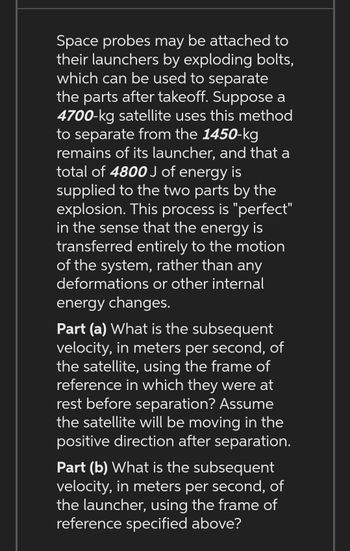Question

Transcribed Image Text:Space probes may be attached to
their launchers by exploding bolts,
which can be used to separate
the parts after takeoff. Suppose a
4700-kg satellite uses this method
to separate from the 1450-kg
remains of its launcher, and that a
total of 4800 J of energy is
supplied to the two parts by the
explosion. This process is "perfect"
in the sense that the energy is
transferred entirely to the motion
of the system, rather than any
deformations or other internal
energy changes.
Part (a) What is the subsequent
velocity, in meters per second, of
the satellite, using the frame of
reference in which they were at
rest before separation? Assume
the satellite will be moving in the
positive direction after separation.
Part (b) What is the subsequent
velocity, in meters per second, of
the launcher, using the frame of
reference specified above?
Expert Solution
This question has been solved!
Explore an expertly crafted, step-by-step solution for a thorough understanding of key concepts.
Step by stepSolved in 3 steps with 3 images

Knowledge Booster
Similar questions
- When there is no air resistance what best describes the vectors of a projectile in motion: a.The acceleration vector and velocity vector are both constant magnitude. b.The acceleration vector is constant magnitude and perpendicular to the trajectory. The velocity vector is at a tangent to the trajectory c.The acceleration vector is constant and points straight down. The velocity vector is perpendicular to the trajectory d.The acceleration vector is constant and points straight down. The velocity vector is at a tangent to the trajectoryarrow_forwardIMPORTANT! For problem 2, set t=1.5 sarrow_forward→ An ion's position vector is initially = 7.01 - 7.01 + 9.0k, and 5.0 s later it is = 5.01 + 6.0 - 5.0k, all in meters. What was its the 5.0 s? (Express your answer in vector form.) V avg Additional Materials m/s Algebra-Squareroots & Squares avg duringarrow_forward
- Use component method to determine resultant displacement. Robin walks 360m [s 40 w] then 580 m [N 30 W] to get to the mallarrow_forwardIXXIU A velocity has magnitude 19 m/s and points downward. For a traditional x-y coordinate system, find the velocity's x and y components. 16. x-component A. 11.21 m/s 0_m/s B. 6.672 m/s 18.1 m/s C. 19.05 m/s 13.88 m/s 1--1 17. y-component -12.44 m/s -19.63 m/s -19_m/s A. -14.33 m/s B. -21.85 m/s C. -25.26_m/s 1--1 DEE D. E. F. D. DEE E. F. MacBook Proarrow_forwarda. Find the Range and Maximum Height of a projectile launched at 4.5 m/s t an angle of 300. Find the Range and Maximum Height of a projectile launched at 4.5 m/s t an angle of 600. Discuss any similarities between a. and b.arrow_forward
- Don't Use Chat GPT Will Upvotearrow_forwardA projectile is hurled to reach a vertical distance of 48 meters and horizontal distance of 510 meters from the launcher. If the projectile is fired at 35 degrees: a. Find the time for the projectile to hit the ground. b. Find the hurling velocity.arrow_forwardPlease solve the all part in 20-25 minutes max thank uarrow_forward
arrow_back_ios
arrow_forward_ios